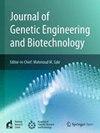Computational identification of dual COX-1 and NIK inhibitors from marine microalga Chlorella vulgaris
IF 2.8
Q3 Biochemistry, Genetics and Molecular Biology
Journal of Genetic Engineering and Biotechnology
Pub Date : 2025-06-30
DOI:10.1016/j.jgeb.2025.100531
引用次数: 0
Abstract
The search for safe and effective anti-inflammatory agents remains a critical area of research due to the widespread impact of chronic inflammatory diseases. Natural compounds, particularly those derived from marine sources, present a promising avenue for developing novel therapeutics. In this study, we investigated the potential of Chlorella vulgaris, a unicellular green alga with a rich profile of bioactive compounds, as a source of anti-inflammatory agents. Through in silico molecular docking and dynamics simulations, we identified compounds C8 and C4 as potent inhibitors of COX-1 and NIK, key targets in inflammatory pathways. These compounds demonstrated significantly stronger binding affinities than standard inhibitors MXM and OWC. For COX-1, C8 and C4 showed binding affinities of −8.625 and −4.359 kcal/mol, respectively, compared to −3.454 kcal/mol for MXM. Similarly, for NIK, the binding affinities were −6.798 and −3.789 kcal/mol for C8 and C4, respectively, compared to −2.628 kcal/mol for OWC. Molecular dynamics simulations further demonstrated that C8 and C4 formed stable interactions, including hydrogen bonds and hydrophobic contacts, with key residues in the active sites of COX-1 and NIK, suggesting a potential for sustained inhibitory activity. These findings highlight the therapeutic potential of C. vulgaris derived compounds for the treatment of inflammatory conditions. Although further in vitro and in vivo studies are necessary to fully elucidate their efficacy and safety, these results provide a promising foundation for the development of novel, naturally sourced anti-inflammatory therapies.

海洋小球藻中COX-1和NIK双抑制剂的计算鉴定
由于慢性炎症性疾病的广泛影响,寻找安全有效的抗炎药物仍然是一个关键的研究领域。天然化合物,特别是来自海洋的天然化合物,为开发新的治疗方法提供了一条有希望的途径。在这项研究中,我们研究了普通小球藻的潜力,一种具有丰富生物活性化合物的单细胞绿藻,作为抗炎药的来源。通过硅分子对接和动力学模拟,我们发现化合物C8和C4是炎症通路关键靶点COX-1和NIK的有效抑制剂。与标准抑制剂MXM和OWC相比,这些化合物表现出明显更强的结合亲和力。对于COX-1, C8和C4的结合亲和力分别为- 8.625和- 4.359 kcal/mol,而MXM的结合亲和力为- 3.454 kcal/mol。同样,对于NIK, C8和C4的结合亲和力分别为- 6.798和- 3.789 kcal/mol,而OWC的结合亲和力为- 2.628 kcal/mol。分子动力学模拟进一步表明,C8和C4与COX-1和NIK活性位点的关键残基形成稳定的相互作用,包括氢键和疏水接触,表明其具有持续抑制活性的潜力。这些发现突出了寻常草衍生化合物治疗炎症的治疗潜力。虽然需要进一步的体外和体内研究来充分阐明其有效性和安全性,但这些结果为开发新的天然抗炎疗法提供了有希望的基础。
本文章由计算机程序翻译,如有差异,请以英文原文为准。
求助全文
约1分钟内获得全文
求助全文
来源期刊

Journal of Genetic Engineering and Biotechnology
Biochemistry, Genetics and Molecular Biology-Biotechnology
CiteScore
5.70
自引率
5.70%
发文量
159
审稿时长
16 weeks
期刊介绍:
Journal of genetic engineering and biotechnology is devoted to rapid publication of full-length research papers that leads to significant contribution in advancing knowledge in genetic engineering and biotechnology and provide novel perspectives in this research area. JGEB includes all major themes related to genetic engineering and recombinant DNA. The area of interest of JGEB includes but not restricted to: •Plant genetics •Animal genetics •Bacterial enzymes •Agricultural Biotechnology, •Biochemistry, •Biophysics, •Bioinformatics, •Environmental Biotechnology, •Industrial Biotechnology, •Microbial biotechnology, •Medical Biotechnology, •Bioenergy, Biosafety, •Biosecurity, •Bioethics, •GMOS, •Genomic, •Proteomic JGEB accepts
 求助内容:
求助内容: 应助结果提醒方式:
应助结果提醒方式:


